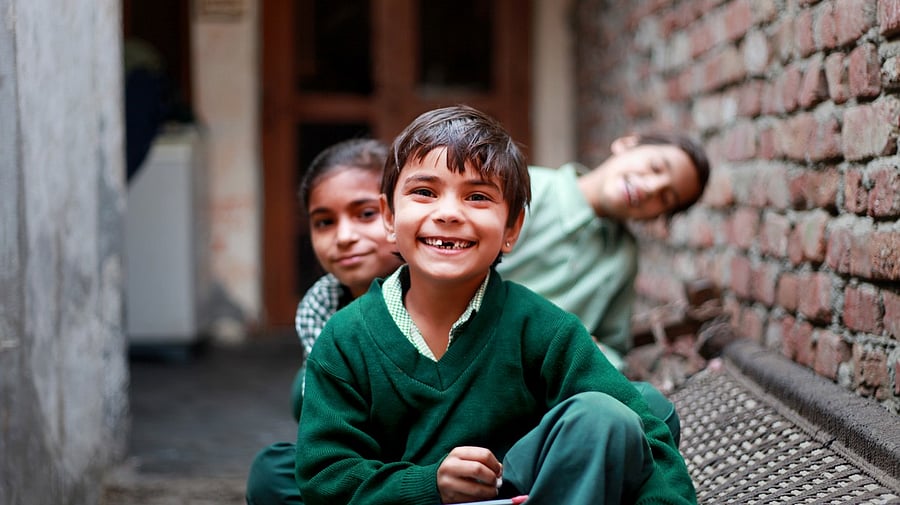
Representative image of Indian children.
Credit: iStock Photo
A recent statement by Rashtriya Swayamsevak Sangh (RSS) chief Mohan Bhagwat’s urging families to have at least three children has reignited discussions on India's population policies. His remarks have brought demographic trends into sharp focus, sparking debates on the societal and economic implications of population growth; it also raises pressing questions about whether India’s current infrastructure can support a larger population with adequate education, healthcare, and social services.
For the past decade, public expenditure on education and healthcare has remained stagnant — below 3 per cent and 2 per cent of GDP, respectively — leaving many to wonder if the State is prepared to meet the needs of a growing populace. Furthermore, over the last seven years, the share of education expenditure in the government budget has declined from 10.7 per cent to 9.2 per cent.
Economic cost of raising children
It is widely acknowledged that economic growth comes with a significant cost, particularly, when it comes to raising children. As India’s rapid urbanisation accelerates, the financial burden of child-rearing in urban centres has become increasingly difficult for many families to bear.
The annual cost of raising a child in metro cities like Mumbai, Delhi, Bengaluru, and Indore, now stands at ₹2.6 lakh, ₹3.19 lakh, ₹3.5 lakh, and ₹4.13 lakh, respectively. While the cost is somewhat lower in rural areas, it remains unaffordable for a significant portion of the population.
Research estimates that the cost of college education is projected to grow at a staggering rate of 10 per cent per year, further increasing the financial strain on families. In this context, it’s worth considering whether encouraging larger families makes sense, especially when the government is already providing free food-grains to more than 80 crore people— over half the population.
With so many families struggling to make ends meet, the question arises: should the focus be on population growth, or should effective population control and prioritising quality of life take precedence? Raising children is increasingly becoming an economic challenge, and the State must carefully consider the long-term implications of policies that promote larger families.
Balancing quantity and quality
Is increasing the population inherently beneficial, or does it risk worsening existing challenges? In economics, population is seen as a factor of production, but the quality of the population plays a far more critical role in sustaining higher economic growth in the long term. Rather than focusing on the number of children, India must prioritise improving the quality of its population by investing in education, healthcare, and skill development. With a population already exceeding 1.4 billion, India is unlikely to face the demographic decline observed in some European countries, making it unnecessary to boost population growth urgently.
India’s labour market reveals a troubling trend where higher education does not guarantee employment. Graduates face a significantly higher jobless rate of 29.1 per cent, compared to 3.4 per cent for those who are illiterate. Similarly, young individuals with secondary or higher education experience an unemployment rate of 18.4 per cent, which is about six times higher than those without formal education. This trend suggests that the job market is struggling to absorb educated individuals, potentially due to a mismatch between educational qualifications and job market demands, or limited opportunities in sectors requiring higher skills.
It underscores the need for structural reforms to create more jobs aligned with the skills of educated youth. Additionally, in a context where providing employment to the existing population is already a challenge, policies advocating for a higher birth rate seem impractical and disconnected from the current economic realities.
Public investment in human capital is falling short, hinting that bigger families might find it hard to make ends meet for their children. This could snowball into underserved and overcrowded communities. Unless education and healthcare get a much-needed boost, chasing numbers over quality could backfire, dragging down the quality of life, economic opportunities, and social progress.
What India really needs is a population that’s armed with the right skills, health, and knowledge to push sustainable development forward, ensuring growth benefits everyone equally.
Disclaimer: The views expressed above are the author's own. They do not necessarily reflect the views of DH.
Atman Shah is assistant professor, Department of Economics, St. Xavier’s College (Autonomous), Ahmedabad.